The entire island of Komodo, Indonesia is a national park, and the main attraction of the park is its wildlife. The ground in the park is very dry and dusty, and the vegetation cannot be described as “verdant.” The island receives an average of four inches of rain per year. Given all this, how can it be so humid?
The picture below is a typical view in the park.
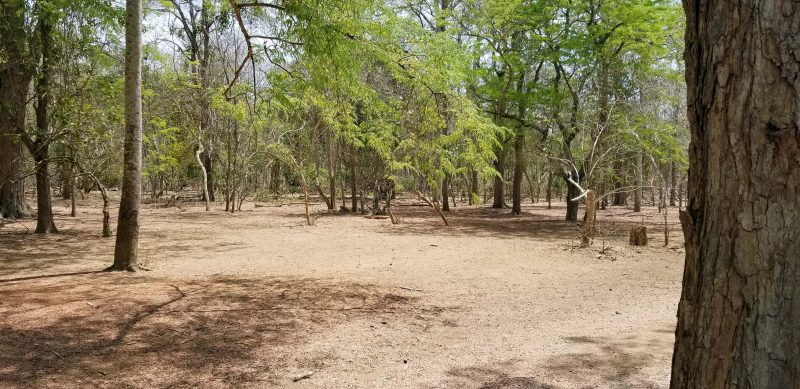
The solitary tree in the photo below (a type of palm) grows only once, meaning that it sprouts, matures, produces fruit, and dies. Its life cycle is about 35 years. This tree is in the fruit stage.
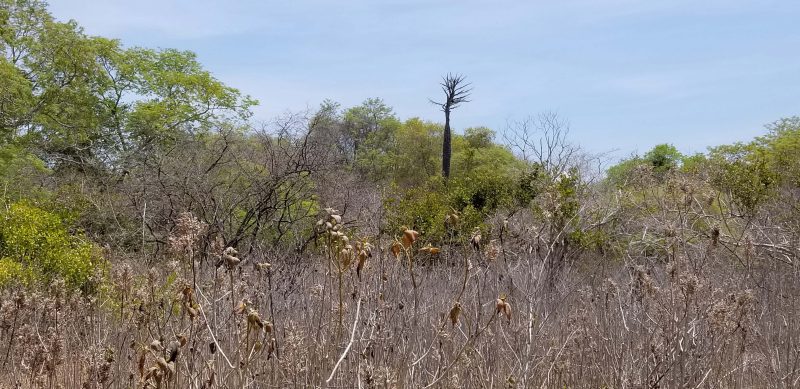
One kind of tree has thorns along one edge of its branches.

In this picture, you can see the stone-bordered path that we were required to stay on.

Komodo is an island, so there are beaches. One of today’s excursions was a visit to the pink coral beach, but Ted and I chose to go to the national park.
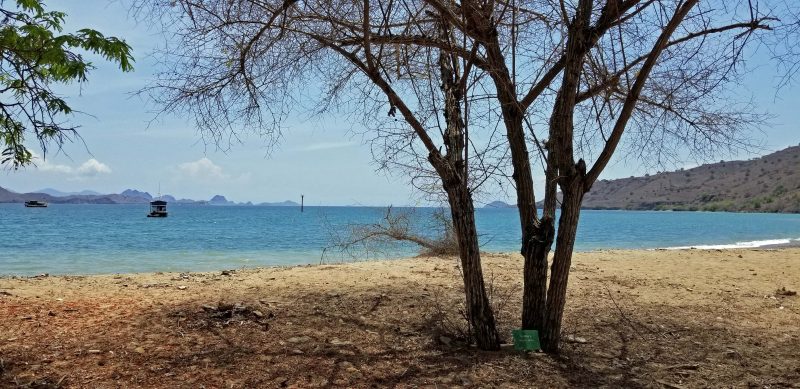
We saw a variety of the park’s famous wildlife. Beginning with the least dangerous and working up to the most dangerous, we saw a large beehive (the dark splotch on the tree trunk). The bees provide honey for the animals.

Look carefully in the shade of the trees just to the right of center in this picture and you’ll see a Timor deer lying on the sand. Komodo is in the Timor Sea.

The park rangers call this path the “animal highway.” It is a main route to the largest watering hole in the park. The dark object in the middle of the highway (left photo) is a sitting wild boar facing us. We stayed quiet, the boar got “boar-ed” (insert groan here), and you can see it walking away from us in the right photo.
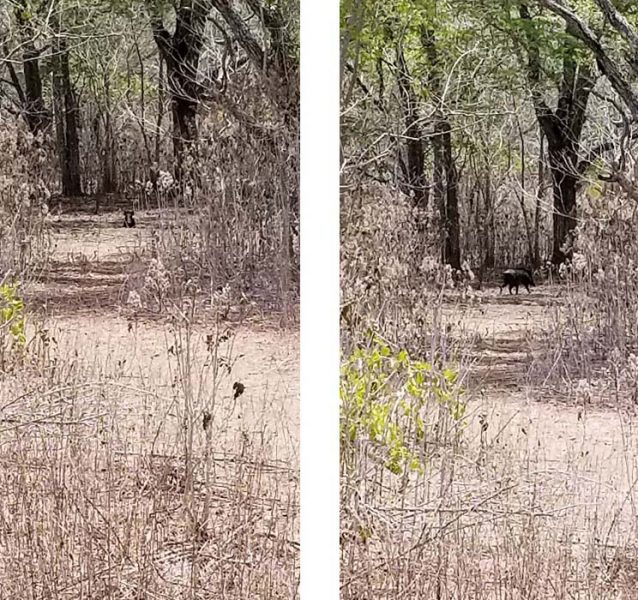
The biggest wildlife attraction in the park is the Komodo dragon, which exists only on four Indonesian Islands, including Komodo. The dragons are a combination of snake and crocodile and are very dangerous. They can grow to 8-10 feet long and weigh up to 200 pounds. One of the large ones in the photos below is about 35 years old.
Komodo dragons can take down animals as large as a water buffalo and can move very quickly for short distances. Their teeth have the ability to re-grow if they are broken from hunting or eating. The saliva of the Komodo dragon contains fourteen kinds of poisonous bacteria, and they kill by attacking with their teeth, injecting their prey with saliva. It can take as long as two weeks for the bacteria to take down a large animal.
Because the dragons are so dangerous, a tour guide wasn’t enough; two experienced park rangers were with us to keep us safe from the wildlife. When the rangers spotted some dragons (they camouflage themselves very well and look like logs), one ranger took a stick and drew a circle around them about twenty feet from where they lay in the dirt. We were warned not to cross that line because the dragons have a keen sense of smell and would attack us if they felt threatened.
There are five dragons in this picture. They are arranged in a triangle (not deliberately, but for my descriptive purpose). Three are piled on each other (like puppies?) at the upper left of the triangle, one is on the left of the large center tree trunk, and one is at the front corner of the triangle. The long brown splotch to the right of the tree trunk is a tree root. From a distance, you can’t be sure: tree root or Komodo dragon?
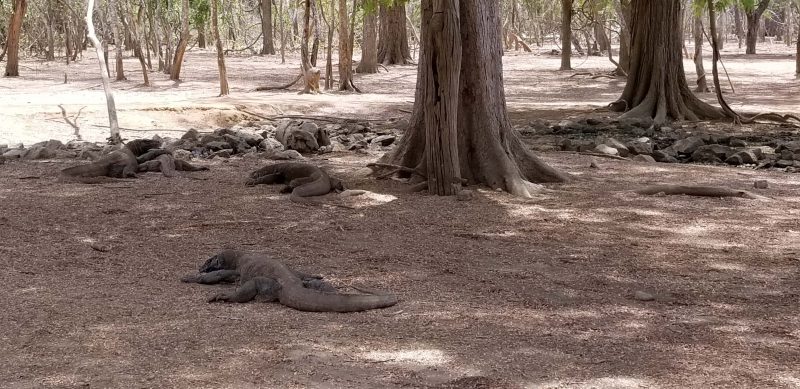
There are also five dragons in this picture: two piled together in the front, one behind them beside the tree, and two more snuggled together off to the right.

Naturally, as we left the park, the path took us through the market, aka gift shop. The vendors are very aggressive as they try to sell their wares. I thought we were safe after getting through this tent, but the path zigzagged back twice more and we had to go through two more markets.
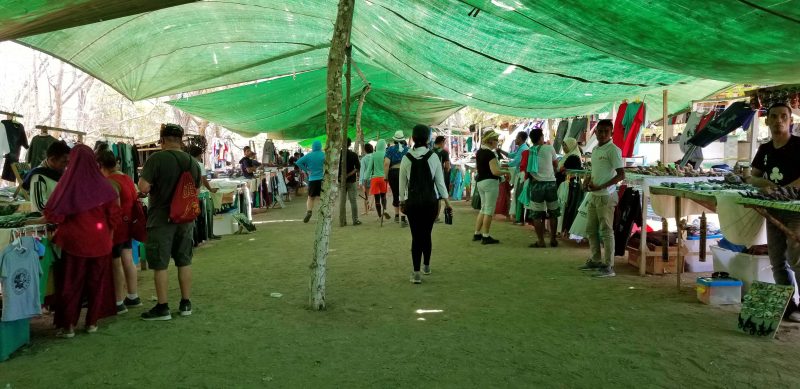
It was hot in Komodo. Eighty-eight degrees and 300% humidity (or so it seemed). We were in the shade throughout the park, but in our 45-minute walk through the park, Ted and I drank four bottles of water and didn’t have to pee. We were fortunate. One man collapsed from the heat and was carried out on a stretcher and immediately transported back to our ship. Two other people in our group left the park in wheelchairs because of heat exhaustion. I believe there were seven or eight groups of people who chose to participate in this excursion, and I assume people in other groups had some heat issues as well.
Waiting for the tender was worse. With only our umbrellas to provide shade, we stood in line on a concrete pier for about 30 minutes before we could board the tender to return to our ship. Some people farther ahead in the line waited nearly an hour as the blazing sun was reflected off the concrete and water. Everyone we’ve spoken with about this excursion enjoyed it, but everyone admits they’ve never been so hot and have never sweated so much in their lives. My suggestion: group us by tender-loads on shore in the shade of the trees. When the tender arrives, send us out onto the fiery pier a group at a time.
The day ended beautifully on our stateroom balcony. Ted thought the sunset was so pretty, he took a picture. Then it got better, so he took another one. We both think it’s the most beautiful sunset we’ve ever seen.

